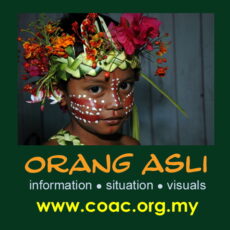On Monday, while our small group was heading for Sabah to attend the Joint Coordination Meeting of the Indigenous Peoples Network of Malaysia (JOAS) we chanced upon Dennis Lau and his wife at KLIA, who were returning to Kuching, Sarawak.
If your involvement with photography started with the digital age, it is unlikely that you would have heard of him. Dennis is from the slide and silver gelatin era (i.e. the film era, in case these terms are alien to you).
For more than 30 years beginning in the mid-1960s, Dennis Lau, of mixed Chinese-Melanau descent, has been documenting the changes facing the native peoples of Borneo. A teacher by profession, his forays into the interior villages were usually done during the school holidays, at his own expense. For him photography was a passion, not a profession.
His works have been exhibited in international salons in Australia, Brunei, England, India, Indonesia, Sabah, Sarawak and Singapore, and also used in various publications (sometimes without him knowing it).
Two books of his photographs have been published thus far, the effort and initiative of friends who saw the value in getting some of his photos reach a wider audience. The first wasPenans – The Vanishing Nomads of Borneo published in 1987, followed 12 years later by Borneo: A photographic journey.
Combining ethnographic photography and photojournalism, his photographs reveal the deep respect and high regard that he feels for the native people, and his empathy for the turmoil they were going through.
Dennis is an unobtrusive photographer. His subjects do not ‘perform’ for him. Rather they treat him as one of them. His unassuming, friendly and warm personality makes people relax and carry on with life as if the camera is not there.
As the Far Eastern Economic Review once noted, “His years of releasing the shutter in the far-flung interior of Sarawak have made him an acute social observer whose subjects seem to respect him as he does them. Hence, the sense of empathy as one looks at the pictures.”
Dennis seems to have skirted the digital age. In the meantime, a whole host of new photographers have emerged employing modern means to get their images to a wide audience quickly and cheaply. It would be nice if all those who enter the homes and lives of indigenous peoples with a view to photographing them, emulate Dennis in their approach and intention.
More on Dennis Lau can be obtained here:http://www.emoss.com.my/info/TravelFeatures/people/dlau.html
His brief website, administered by his artist-daughter, can be viewed here:http://dennislauborneo.net/
Sze Ning showing Yein, Azmi and Yusri the few photos by Dennis that are available on the internet.
Not many of Dennis’s photos can be found on the internet. Even those published in his two books are hard to locate on the web. And the books were published in low volumes (only 200 copies of Penans: The Vanishing Tribes of Borneo were published).
Many of Dennis’s photos have not been published. He now wants to get them out. Several valuable slides have already been binned due to poor quality chemicals used in the processing then. But the problem now is to find someone to help him digitize his remaining negatives and slides.

